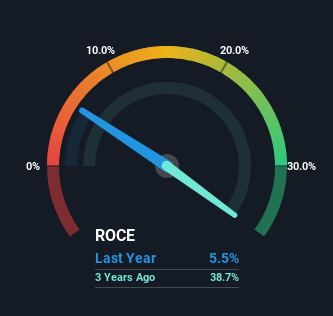- India
- /
- Professional Services
- /
- NSEI:SPECTSTM
Spectrum Talent Management (NSE:SPECTSTM) Could Be Struggling To Allocate Capital
If we want to find a potential multi-bagger, often there are underlying trends that can provide clues. One common approach is to try and find a company with returns on capital employed (ROCE) that are increasing, in conjunction with a growing amount of capital employed. Ultimately, this demonstrates that it's a business that is reinvesting profits at increasing rates of return. However, after briefly looking over the numbers, we don't think Spectrum Talent Management (NSE:SPECTSTM) has the makings of a multi-bagger going forward, but let's have a look at why that may be.
What Is Return On Capital Employed (ROCE)?
Just to clarify if you're unsure, ROCE is a metric for evaluating how much pre-tax income (in percentage terms) a company earns on the capital invested in its business. The formula for this calculation on Spectrum Talent Management is:
Return on Capital Employed = Earnings Before Interest and Tax (EBIT) ÷ (Total Assets - Current Liabilities)
0.055 = ₹85m ÷ (₹2.3b - ₹718m) (Based on the trailing twelve months to September 2024).
Therefore, Spectrum Talent Management has an ROCE of 5.5%. In absolute terms, that's a low return and it also under-performs the Professional Services industry average of 11%.
View our latest analysis for Spectrum Talent Management

While the past is not representative of the future, it can be helpful to know how a company has performed historically, which is why we have this chart above. If you're interested in investigating Spectrum Talent Management's past further, check out this free graph covering Spectrum Talent Management's past earnings, revenue and cash flow.
How Are Returns Trending?
On the surface, the trend of ROCE at Spectrum Talent Management doesn't inspire confidence. Around four years ago the returns on capital were 34%, but since then they've fallen to 5.5%. However, given capital employed and revenue have both increased it appears that the business is currently pursuing growth, at the consequence of short term returns. If these investments prove successful, this can bode very well for long term stock performance.
On a related note, Spectrum Talent Management has decreased its current liabilities to 32% of total assets. So we could link some of this to the decrease in ROCE. Effectively this means their suppliers or short-term creditors are funding less of the business, which reduces some elements of risk. Some would claim this reduces the business' efficiency at generating ROCE since it is now funding more of the operations with its own money.
What We Can Learn From Spectrum Talent Management's ROCE
Even though returns on capital have fallen in the short term, we find it promising that revenue and capital employed have both increased for Spectrum Talent Management. And long term investors must be optimistic going forward because the stock has returned a huge 124% to shareholders in the last year. So while investors seem to be recognizing these promising trends, we would look further into this stock to make sure the other metrics justify the positive view.
Spectrum Talent Management does have some risks, we noticed 4 warning signs (and 2 which make us uncomfortable) we think you should know about.
For those who like to invest in solid companies, check out this free list of companies with solid balance sheets and high returns on equity.
New: Manage All Your Stock Portfolios in One Place
We've created the ultimate portfolio companion for stock investors, and it's free.
• Connect an unlimited number of Portfolios and see your total in one currency
• Be alerted to new Warning Signs or Risks via email or mobile
• Track the Fair Value of your stocks
Have feedback on this article? Concerned about the content? Get in touch with us directly. Alternatively, email editorial-team (at) simplywallst.com.
This article by Simply Wall St is general in nature. We provide commentary based on historical data and analyst forecasts only using an unbiased methodology and our articles are not intended to be financial advice. It does not constitute a recommendation to buy or sell any stock, and does not take account of your objectives, or your financial situation. We aim to bring you long-term focused analysis driven by fundamental data. Note that our analysis may not factor in the latest price-sensitive company announcements or qualitative material. Simply Wall St has no position in any stocks mentioned.
About NSEI:SPECTSTM
Spectrum Talent Management
Provides manpower solutions in India and internationally.
Excellent balance sheet with low risk.
Similar Companies
Market Insights
Community Narratives




